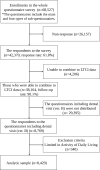Differences in Cumulative Long-Term Care Costs by Dental Visit Pattern Among Japanese Older Adults: The JAGES Cohort Study
- PMID: 39101529
- PMCID: PMC11369224
- DOI: 10.1093/gerona/glae194
Differences in Cumulative Long-Term Care Costs by Dental Visit Pattern Among Japanese Older Adults: The JAGES Cohort Study
Abstract
Background: Long-term care (LTC) costs create burdens on aging societies. Maintaining oral health through dental visits may result in shorter LTC periods, thereby decreasing LTC costs; however, this remains unverified. We examined whether dental visits in the past 6 months were associated with cumulative LTC insurance (LTCI) costs.
Methods: This cohort study of the Japan Gerontological Evaluation Study targeted independent adults aged≥65 years in 2010 over an 8-year follow-up. We used data from a self-reported questionnaire and LTCI records from the municipalities. The outcome was cumulative LTCI costs, and exposure was dental visits within 6 months for prevention, treatment, and prevention or treatment. A 2-part model was used to estimate the differences in the predicted cumulative LTCI costs and 95% confidence intervals (CIs) for each dental visit.
Results: The mean age of the 8 429 participants was 73.7 years (standard deviation [SD] = 6.0), and 46.1% were men. During the follow-up period, 17.6% started using LTCI services. The mean cumulative LTCI cost was USD 4 877.0 (SD = 19 082.1). The predicted cumulative LTCI costs were lower among those had dental visits than among those who did not. The differences in predicted cumulative LTCI cost were -USD 1 089.9 (95% CI = -1 888.5 to -291.2) for dental preventive visits, -USD 806.7 (95% CI = -1 647.4 to 34.0) for treatment visits, and -USD 980.6 (95% CI = -1 835.7 to -125.5) for preventive or treatment visits.
Conclusions: Dental visits, particularly preventive visits, were associated with lower cumulative LTCI costs. Maintaining oral health through dental visits may effectively reduce LTCI costs.
Keywords: Epidemiology; Health services; Public health.
© The Author(s) 2024. Published by Oxford University Press on behalf of The Gerontological Society of America.
Conflict of interest statement
None.
Figures
Similar articles
-
Difference in long-term care cost obtained with the short-term intensive prevention service (day service type C): A 3-year follow-up study of Japanese older adults.Geriatr Gerontol Int. 2025 Aug;25(8):1058-1064. doi: 10.1111/ggi.70102. Epub 2025 Jun 19. Geriatr Gerontol Int. 2025. PMID: 40538113 Free PMC article.
-
Chlorhexidine mouthrinse as an adjunctive treatment for gingival health.Cochrane Database Syst Rev. 2017 Mar 31;3(3):CD008676. doi: 10.1002/14651858.CD008676.pub2. Cochrane Database Syst Rev. 2017. PMID: 28362061 Free PMC article.
-
Impact of Long-Term Care Insurance on health out-of-pocket expenditure ratios for older adults.Front Public Health. 2025 Jul 15;13:1616761. doi: 10.3389/fpubh.2025.1616761. eCollection 2025. Front Public Health. 2025. PMID: 40735199 Free PMC article.
-
Sertindole for schizophrenia.Cochrane Database Syst Rev. 2005 Jul 20;2005(3):CD001715. doi: 10.1002/14651858.CD001715.pub2. Cochrane Database Syst Rev. 2005. PMID: 16034864 Free PMC article.
-
The effectiveness and cost-effectiveness of carmustine implants and temozolomide for the treatment of newly diagnosed high-grade glioma: a systematic review and economic evaluation.Health Technol Assess. 2007 Nov;11(45):iii-iv, ix-221. doi: 10.3310/hta11450. Health Technol Assess. 2007. PMID: 17999840
Cited by
-
A Cross-Sectional Study on the Relationship Between Social Media Use and Frailty Among the Older People in Japan.Int J Environ Res Public Health. 2025 Jan 22;22(2):142. doi: 10.3390/ijerph22020142. Int J Environ Res Public Health. 2025. PMID: 40003368 Free PMC article.
References
-
- OECD. Health at a Glance 2023: OECD Indicators. Paris: OECD Publishing; 2023. 10.1787/7a7afb35-en. - DOI
-
- Japan Cabinet Office. White paper on aging society 2022; 2022. https://www8.cao.go.jp/kourei/whitepaper/w-2022/zenbun/04pdf_index.html. Accessed December 10, 2022.
-
- Ministry of Health, Labour and Welfare. Handbook of health and welfare statistics 2021; 2021. https://www.mhlw.go.jp/english/database/db-hh/5-1.html. Accessed January 6, 2023.
Publication types
MeSH terms
Grants and funding
LinkOut - more resources
Full Text Sources
Miscellaneous


